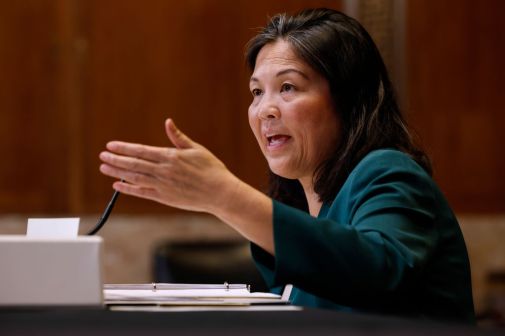 After 4.5 years as deputy secretary at the Labor Department, Seth Harris is stepping down to spend some time with his family and pursue other interests.
After 4.5 years as deputy secretary at the Labor Department, Seth Harris is stepping down to spend some time with his family and pursue other interests.As government employees evolve with technology, how do the federal leaders of that workforce adjust to the changing times?
In a career that spans more than 30 years in labor law and policy, Seth Harris, departing deputy secretary at the Labor Department, has seen a transformation he describes as the “ubiquity of sophisticated technology.”
The rise of technology in the workplace has indeed been significant. But according to Harris, a key change is the ability of federal employees to carry out their mission in an unconventional way.
“Continuing to do things the way you’ve always done them and expecting the same thing is definition of insanity — innovation means trying something different and seeing if it works more broadly,” Harris told FedScoop.
More change is on the way for Harris. FedScoop reported Dec. 13, 2013 Harris had announced his resignation from the Labor Department, where he has served as deputy secretary for 4.5 years. He also served as acting secretary for six months in 2013, and previously worked in other roles at Labor.
Like many federal leaders, being a civil servant has meant encountering various cultural difficulties.
“One of the challenges with respect to creating a culture of innovation is accepting failure,” he said. “Innovation necessitates a certain amount of failure. One of the challenges for government is everything we do is scrutinized so closely. People are held to account for even the slightest slip-up that innovation becomes extremely difficult.”
One strategy he’s undertaken at Labor is engaging the public — particularly the developer community — conceptualizing and building new tools that will help the department carry out its mission in what Harris described as “unexpected ways.”
Two apps especially embody that type of innovation and application of technology; the Fair Labor App and the Eat Sleep Shop app. The two apps use Labor enforcement data and combine it with mapping technology and information found on Yelp and other consumer sites.
The Eat Sleep Shop app helps the public understand which retailers, restaurants, hotels and other commercial establishments are violating minimum wage, overtime, workplace safety and health laws. It “allows consumers to put pressure on employers to follow the law without the Labor Department ever having to go on site — and it does that by saying to employers, the public knows what you’re doing,” Harris said.
While Harris wasn’t involved in designing these apps, he spent time promoting them via videos, press interviews and engaging with the public, bringing focus to the developer community and the overall work Labor is doing.
At the department level, it’s becoming more common for cabinet leaders to champion technology agendas. While the overarching role of chief information officers in federal government is to manage the IT infrastructure in agencies, they may benefit from added weight in their corner, especially if that help comes from a presidential appointee. For example, Commerce Secretary Penny Pritzker demonstrated that type of support when she unveiled a plan to unleash the department’s data to drive overall entrepreneurship and innovation.
Opening up more of the Labor data through data.gov and safety.data.gov has also been an interest for Harris. The department has been providing workplace safety and health information from the Occupational Health and Safety Administration, but also working with Environmental Protection Agency, Transportation Department and other organizations to liberate the maximum amount of data.
“We’re not interested in data liberation for its own sake; we liberate data because we think it will allow the public to help us do our job better, to hold us accountable and to come up with innovative ways of changing behavior in the public that results in better work lives for working families,” Harris explained.
Harris said the work he is proudest of at Labor is using technology as an example to get people to think differently about their jobs.
“We have traditional tools and we want to do the best we can with traditional tools, but getting people to think about different kinds of tools and different strategies and approaches, I think has helped create a culture of innovation in the department,” he said.
He describes his work at Labor as a “profound privilege,” but is looking forward this next chapter. For Harris, a shift in careers means more time with family. After his exit, Harris will be taking a break from government and get back into old loves; he plans to write, practice law and use the knowledge gained and lessons learned at Labor to consult for other governments and organizations.





